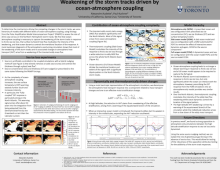Weakening of the storm tracks driven by ocean-atmosphere coupling
Alexandre
Audette
University of California Santa Cruz
Poster
Within the changing climate, the Northern Hemisphere storm tracks are
projected to shift poleward and expand eastward. Changes in the Northern
Hemisphere storm tracks arise from a variety of sometimes competing
effects on the region’s baroclinicity. Arctic amplification weakens the
meridional temperature gradient, hence weakening the storm track, while
low latitude warming has the opposite effect, and surface-amplified warming
at high latitudes reduces static stability. To determine the mechanisms
driving these competing changes, we use a hierarchy of models with
different levels of ocean-atmosphere coupling, using forcings from the Polar
Amplification Model Intercomparison Project (PAMIP) to assess the role of
Arctic sea ice loss on the Northern Hemisphere storm tracks. We find that
ocean-atmosphere coupling is necessary to capture the weakening of the
storm tracks in response to Arctic sea ice loss, that surface turbulent heat
flux modulates the intensity of the weakening, and that ocean dynamics
controls the meridional location of the response. A moist isentropic
diagnostic of the atmospheric overturning circulation shows that most of the
weakening of the storm tracks and its associated changes in atmospheric
heat transport (AHT) arise from a weakening of the transient eddy mass flux.
Poleward of the storm tracks, the AHT also decreases, but through weakened
effective stratification rather than weakening mass fluxes.
projected to shift poleward and expand eastward. Changes in the Northern
Hemisphere storm tracks arise from a variety of sometimes competing
effects on the region’s baroclinicity. Arctic amplification weakens the
meridional temperature gradient, hence weakening the storm track, while
low latitude warming has the opposite effect, and surface-amplified warming
at high latitudes reduces static stability. To determine the mechanisms
driving these competing changes, we use a hierarchy of models with
different levels of ocean-atmosphere coupling, using forcings from the Polar
Amplification Model Intercomparison Project (PAMIP) to assess the role of
Arctic sea ice loss on the Northern Hemisphere storm tracks. We find that
ocean-atmosphere coupling is necessary to capture the weakening of the
storm tracks in response to Arctic sea ice loss, that surface turbulent heat
flux modulates the intensity of the weakening, and that ocean dynamics
controls the meridional location of the response. A moist isentropic
diagnostic of the atmospheric overturning circulation shows that most of the
weakening of the storm tracks and its associated changes in atmospheric
heat transport (AHT) arise from a weakening of the transient eddy mass flux.
Poleward of the storm tracks, the AHT also decreases, but through weakened
effective stratification rather than weakening mass fluxes.

